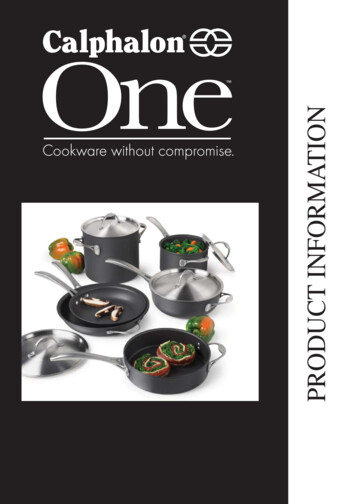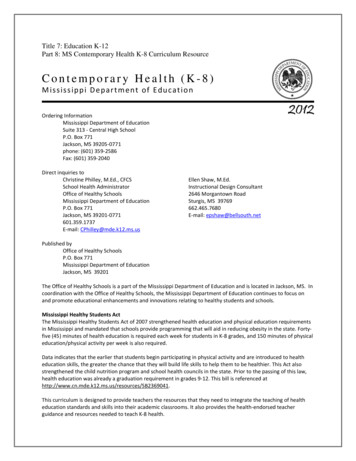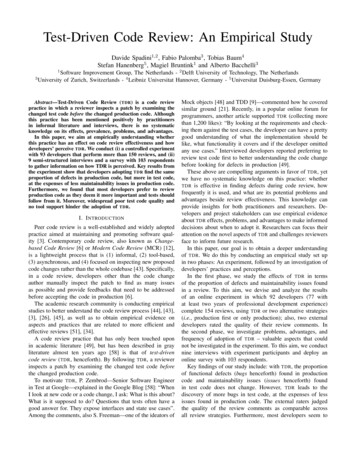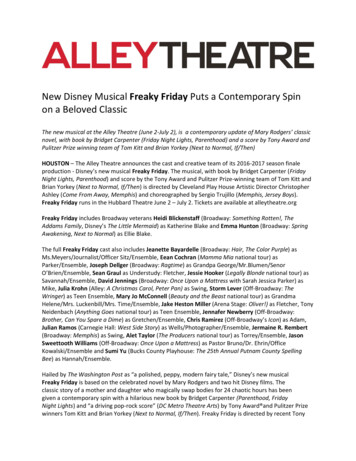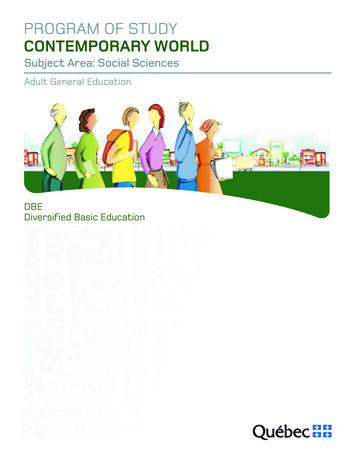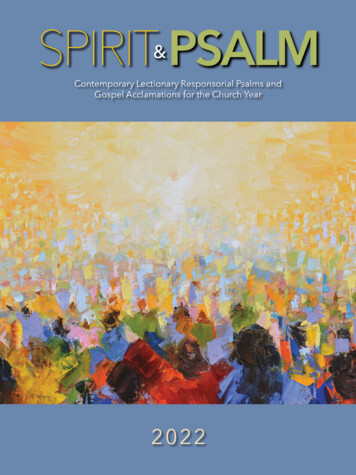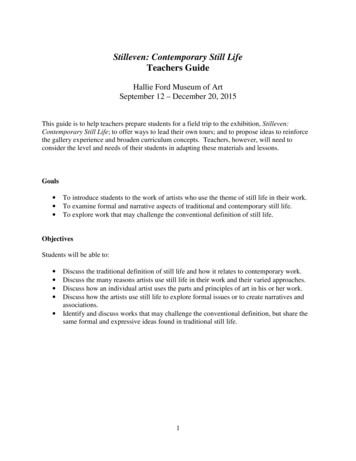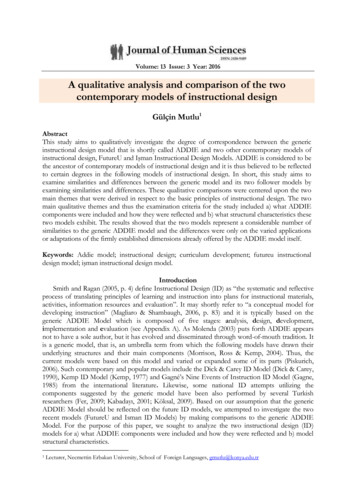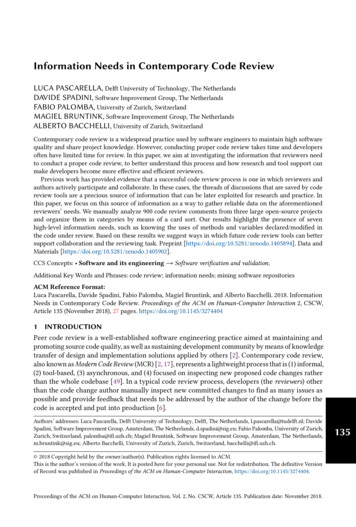
Transcription
Information Needs in Contemporary Code ReviewLUCA PASCARELLA, Delft University of Technology, The NetherlandsDAVIDE SPADINI, Software Improvement Group, The NetherlandsFABIO PALOMBA, University of Zurich, SwitzerlandMAGIEL BRUNTINK, Software Improvement Group, The NetherlandsALBERTO BACCHELLI, University of Zurich, SwitzerlandContemporary code review is a widespread practice used by software engineers to maintain high softwarequality and share project knowledge. However, conducting proper code review takes time and developersoften have limited time for review. In this paper, we aim at investigating the information that reviewers needto conduct a proper code review, to better understand this process and how research and tool support canmake developers become more effective and efficient reviewers.Previous work has provided evidence that a successful code review process is one in which reviewers andauthors actively participate and collaborate. In these cases, the threads of discussions that are saved by codereview tools are a precious source of information that can be later exploited for research and practice. Inthis paper, we focus on this source of information as a way to gather reliable data on the aforementionedreviewers’ needs. We manually analyze 900 code review comments from three large open-source projectsand organize them in categories by means of a card sort. Our results highlight the presence of sevenhigh-level information needs, such as knowing the uses of methods and variables declared/modified inthe code under review. Based on these results we suggest ways in which future code review tools can bettersupport collaboration and the reviewing task. Preprint [https://doi.org/10.5281/zenodo.1405894]. Data andMaterials [https://doi.org/10.5281/zenodo.1405902].CCS Concepts: Software and its engineering Software verification and validation;Additional Key Words and Phrases: code review; information needs; mining software repositoriesACM Reference Format:Luca Pascarella, Davide Spadini, Fabio Palomba, Magiel Bruntink, and Alberto Bacchelli. 2018. InformationNeeds in Contemporary Code Review. Proceedings of the ACM on Human-Computer Interaction 2, CSCW,Article 135 (November 2018), 27 pages. https://doi.org/10.1145/32744041INTRODUCTIONPeer code review is a well-established software engineering practice aimed at maintaining andpromoting source code quality, as well as sustaining development community by means of knowledgetransfer of design and implementation solutions applied by others [2]. Contemporary code review,also known as Modern Code Review (MCR) [2, 17], represents a lightweight process that is (1) informal,(2) tool-based, (3) asynchronous, and (4) focused on inspecting new proposed code changes ratherthan the whole codebase [49]. In a typical code review process, developers (the reviewers) otherthan the code change author manually inspect new committed changes to find as many issues aspossible and provide feedback that needs to be addressed by the author of the change before thecode is accepted and put into production [6].Authors’ addresses: Luca Pascarella, Delft University of Technology, Delft, The Netherlands, l.pascarella@tudelft.nl; DavideSpadini, Software Improvement Group, Amsterdam, The Netherlands, d.spadini@sig.eu; Fabio Palomba, University of Zurich,Zurich, Switzerland, palomba@ifi.uzh.ch; Magiel Bruntink, Software Improvement Group, Amsterdam, The Netherlands,m.bruntink@sig.eu; Alberto Bacchelli, University of Zurich, Zurich, Switzerland, bacchelli@ifi.uzh.ch. 2018 Copyright held by the owner/author(s). Publication rights licensed to ACM.This is the author’s version of the work. It is posted here for your personal use. Not for redistribution. The definitive Versionof Record was published in Proceedings of the ACM on Human-Computer Interaction, https://doi.org/10.1145/3274404.Proceedings of the ACM on Human-Computer Interaction, Vol. 2, No. CSCW, Article 135. Publication date: November 2018.135
135:2L. Pascarella et al.Modern code review is a collaborative process in which reviewers and authors conduct anasynchronous online discussion to ensure that the proposed code changes are of sufficiently highquality [2] and fit the project’s direction [26] before they are accepted. In code reviews, discussionsrange from low-level concerns (e.g., variable naming and code style) up to high-level considerations(e.g., fit within the scope of the project and future planning) and encompass both functional defectsand evolutionary aspects [10]. For example a reviewer may ask questions regarding the structureof the changed code [57] or clarifications about the rationale behind some design decisions [55],another reviewer may respond or continue the thread of questions, and the author can answer thequestions (e.g., explaining the motivation that led to a change) and implement changes to the codeto address the reviewers’ remark.Even though studies have shown that modern code review has the potential to support softwarequality and dependability [17, 39, 41], researchers have also provided strong empirical evidencethat the outcome of this process is rather erratic and often unsatisfying or misaligned with theexpectations of participants [2, 10, 37]. This erratic outcome is caused by the cognitive-demandingnature of reviewing [7], whose outcome mostly depends on the time and zeal of the involvedreviewers [17].Based on this, a large portion of the research efforts on tools and processes to help code reviewingis explicitly or implicitly based on the assumption that reducing the cognitive load of reviewersimproves their code review performance [7]. In the current study, we continue on this line of bettersupporting the code review process through the reduction of reviewers’ cognitive load. Specifically,our goal is to investigate the information that reviewers need to conduct a proper code review. We arguethat—if this information would be available at hand—reviewers could focus their efforts and timeon correctly evaluating and improving the code under review, rather than spending cognitive effortand time on collecting the missing information. By investigating reviewers’ information needs, wecan better understand the code review process, guide future research efforts, and envision howtool support can make developers become more effective and efficient reviewers.To gather data about reviewers’ information needs we turn to one of the collaborative aspectsof code review, namely the discussions among participants that happen during this process. Infact, past research has shown that code review is more successful when there is a functioningcollaboration among all the participants. For example, Rigby et al. reported that the efficiencyand effectiveness of code reviews are most affected by the amount of review participation [50];Kononenko et al. [34] showed that review participation metrics are associated with the quality ofthe code review process; McIntosh et al. found that a lack of review participation can have a negativeimpact on long-term software quality [39, 60]; and Spadini et al. studied review participation inproduction and test files, presenting a set of identified obstacles limiting the review of code [54].For this reason, from code review communication, we expect to gather evidence of reviewers’information needs that are solved through the collaborative discussion among the participants.To that end, we consider three large open-source software projects and manually analyze 900code review discussion threads that started from a reviewer’s question. We focus on what kindof questions are asked in these comments and their answers. As shown in previous research[12, 14, 33, 56], such questions can implicitly represent the information needs of code reviewers. Inaddition, we conduct four semi-structured interviews with developers from the considered systemsand one focus group with developers from a software quality consultancy firm, both to challenge ouroutcome and to discuss developers’ perceptions. Better understanding what reviewers’ informationneeds are can lead to reduced cognitive load for the reviewers, thus leading, in turn, to better andshorter reviews. Furthermore, knowing these needs helps driving the research community towardthe definition of methodologies and tools able to properly support code reviewers when verifyingnewly submitted code changes.Proceedings of the ACM on Human-Computer Interaction, Vol. 2, No. CSCW, Article 135. Publication date: November 2018.
Information Needs in Contemporary Code Review135:3Our analysis led to seven high-level information needs, such as knowing the uses of methodsand variables declared/modified in the code under review, and their analysis in the code reviewlifecycle. Among our results, we found that the needs to know (1) whether a proposed alternativesolution is valid and (2) whether the understanding of the reviewer about the code under review iscorrect are the most prominent ones. Moreover, all the reviewers’ information needs are replied towithin a median time of seven hours, thus pointing to the large time savings that can be achievedby addressing these needs through automated tools. Based on these results, we discuss how futurecode review tools can better support collaboration and the reviewing task.2BACKGROUND AND RELATED WORKThis section describes the basic components that form a modern code review as well as the literaturerelated to information needs and code review participation.2.1Background: The code review processFigure 1 depicts a code review (pertaining to the OpenStack project) done with a typical codereview tool. Although this is one of the many available review tools, their functionalities are largelythe same [65]. In the following we briefly describe each of the components of a review as providedby code review tools.Code review tools provide an ID and a status (part 1 in Figure 1) for each code review, whichare used to track the code change and know whether it has been merged (i.e., put into production)or abandoned (i.e., it has been evaluated as not suitable for the project). Code review tools alsoallow the change author to include a textual description of the code change, with the aim toprovide reviewers with more information on the rationale and behavior of the change. However,past research has provided evidence that the quality and level of detail of the descriptions thataccompany code changes are often suboptimal [57], thus making it harder for reviewers to properlyunderstand the code change through this support. The fact that the change description is often notoptimal strengthens the importance of the goal of our study: An improved analysis of developers’needs in code review can provide benefits in terms of review quality [34].The second component of a typical code review tool is a view on the technical meta-informationon the change under review (part 2 in Figure 1). This meta-information include author andcommitter of the code change, commit ID, parent commit ID, and change ID, which can be used totrack the submitted change over the history of the project.Part 3 of the tool in Figure 1 reports, instead, more information on who are the reviewersassigned for the inspection of the submitted code change, while part 4 lists the source code filesmodified in the commit (i.e., the files on which the review will be focused).Finally, part 5 is the core component of a code review tool and the one that involves mostcollaborative aspects. It reports the discussion that author and reviewers are having on the submittedcode change. In particular, reviewers can ask clarifications or recommend improvements to theauthor, who can instead reply to the comments and propose alternative solutions. This mechanismis often accompanied by the upload of new versions of the code change (i.e., revised patches oriterations), which lead to an iterative process until all the reviewers are satisfied with the change ordecide to not include it into production. Figure 2 shows a different view that contains both reviewsand authors comments. In this case, the involved developers discuss about a specific line of code,as opposed to Alice from the previous example who commented on the entire code change (Figure1, end of part 5 ).Proceedings of the ACM on Human-Computer Interaction, Vol. 2, No. CSCW, Article 135. Publication date: November 2018.
135:4L. Pascarella et al.OwnerChange 107871 - Merged1BobImplement EDP for a Spark standalone clusterReviewersThis change adds an EDP engine for a Spark standalone cluster.The engine uses the spark-submit script and various linuxcommands via ssh to run, monitor, and terminate Spark jobs.EdwardAliceA directory is created for each Spark job on the master node whichcontains jar files, the script used to launch the job, thejob's stderr and stdout, and a result file containing the exitstatus of spark-submit. The directory is named after the Saharajob and the job execution id so it is easy to locate. Preservingthese files is a big help in debugging jobs.A few general improvements are included:* engine.cancel job() may return updated job status* engine.run job() may return job status and fields forjob execution.extrain addition to job idtype (new CR)on the master node configurable (new CR)job directories on the master node (new CR)general options to spark-submit itself (newJohnRobRyanSamEnzoCurrently, the Spark engine can launch "Java" job types (this isthe same type used to submit Oozie Java action on Hadoop clusters)Still to do:* create a proper Spark job* make the job dir location* add something to clean up* allows users to pass someCR)Trevor ervice/edp/job ervice/edp/job rvice/edp/resources/launch /tests/unit/service/edp/spark/ init .pysahara/tests/unit/service/edp/spark/test spark.pysahara/tests/unit/service/edp/test job manager.py3Comments433464618766161038310Partial implements: blueprint edp-spark-standaloneChange-Id: ice alice@redhat.com CommitterAlice alice@redhat.com ryAliceUploaded patch set 1 .BobPatch Set 1:sahara/service/edp/job manager.pyLine 68:should this be guarded with:if job info.get('status') in job utils.terminated job states:just in case 'status' doesn't exist?Alice5Patch Set 4:The patch LGTM, apart from the small comment on the commit message.One important question, though, is about the data sources. How is input and output specified for each jon submitted through Spark EDP?Spark does not support Swift for now, so I would expect only HDFS to be available.Fig. 1. Example of code review mined from Gerrit.2.2Related WorkOver the last decade the research community spent a considerable effort in studying code reviews(e.g., [3, 10, 11, 17, 20, 32, 54]). In this section, we compare and contrast our work to previousresearch in two areas: first, we consider studies that investigate the information needs of developersin various contexts, then we analyze previous research that focused on code review discussion,participation, and time.2.2.1 Information needs. Breu et al. [12] conducted a study—which has been a great inspirationto the current study we present here—on developers’ information needs based on the analysis ofcollaboration among users of a software egineering tool (i.e., issue tracking system). In their study,the authors have quantitatively and qualitatively analyzed the questions asked in a sample of 600Proceedings of the ACM on Human-Computer Interaction, Vol. 2, No. CSCW, Article 135. Publication date: November 2018.
Information Needs in Contemporary Code Review26 class d29def setUpClass(cls):30super(FormPostTest, cls).setUpClass()31cls.key cache time (32cls.objectstorage api config.tempurl key cache time)33cls.tempurl key cls.behaviors.VALID TEMPURL KEY34cls.object name cls.behaviors.VALID OBJECT NAME35cls.object data cls.behaviors.VALID OBJECT DATA36cls.content length str(len(cls.behaviors.VALID OBJECT DATA))37cls.http client HTTPClient()38cls.redirect url "http://example.com/form post test"39135:526 class d29def setUpClass(cls):30super(FormPostTest, cls).setUpClass()31cls.key cache time (32cls.objectstorage api config.tempurl key cache time)3334353637383940414243cls.object name cls.behaviors.VALID OBJECT NAMEcls.object data cls.behaviors.VALID OBJECT DATAcls.content length str(len(cls.behaviors.VALID OBJECT DATA))cls.http client HTTPClient()cls.redirect url "http://example.com/form post test"keys set cls.behaviors.check account tempurl keys()if keys set:metadata response cls.client.get account metadata()cls.tempurl key \metadata )Apr 22, 2015AliceShould there be a default value for the cls.tempurl key, or should the fixture assert if keys set is empty?All of the tests depend on the attribute, but for whatever reason, if the X-Account-Meta-Temp-Url-Key is notpresent in the headers, the attribute will not exist, and the tests will error out in a ungraceful manner.ReplyQuoteDoneApr 22, 2015BobSo the check account tempurl keys method will first check to see if the account keys are set and if theyaren't, it will set them to some defaults. If, for some reason, it fails to set them properly, keys set should beFalse instead of True. So, what I will do is have an else statement here which will raise an Exception but inall likelihood it would fail in the behaviors ed features('formpost')def test object formpost ixture.required features('formpost')def test object formpost redirect(self):"""Fig. 2. Example of code review comments mined from Gerrit.bug reports from two open-source projects, deriving a set of information needs in bug reports. Theauthors showed that active and ongoing participation were important factors needed for makingprogress on the bugs reported by users and they suggested a number of actions to be performed bythe researchers and tool vendors in order to improve bug tracking systems.Ko et al. [33] studied information needs of developers in collocated development teams. Theauthors observed the daily work of developers and noted the types of information desired. Theyidentified 21 different information types in the collected data and discussed the implications of theirfindings for software designers and engineers. Buse and Zimmermann [14] analyzed developers’needs for software development analytics: to that end, they surveyed 110 developers and projectmanagers. With the collected responses, the authors proposed several guidelines for analytics toolsin software development.Sillito et al. [53] conducted a qualitative study on the questions that programmers ask whenperforming change tasks. Their aim was to understand what information a programmer needs toknow about a code base while performing a change task and also how they go about discoveringthat information. The authors categorized and described 44 different kinds of questions asked bythe participants. Finally, Herbsleb et al. [29] analyzed the types of questions that get asked duringdesign meetings in three organizations. They found that most questions concerned the projectrequirements, particularly what the software was supposed to do and, somewhat less frequently,scenarios of use. Moreover, they also discussed the implications of the study for design tools andmethods.The work we present in this paper is complementary with respect to the ones discussed so far:indeed, we aim at making a further step ahead investigating the information needs of developersthat review code changes with the aim of deepening our understanding of the code review processand of leading to future research and tools to better support reviewers in conducting their tasks.2.2.2 Code Review Participation and Time. Extensive work has been done by the software engineeringresearch community in the context of code review participation. Abelein et al. [1] investigatedthe effects of user participation and involvement on system success and explored which methodsProceedings of the ACM on Human-Computer Interaction, Vol. 2, No. CSCW, Article 135. Publication date: November 2018.
135:6L. Pascarella et al.are available in literature, showing that it can have a significant correlation with system quality.Thongtanunam et al. [62] showed that reviewing expertise (which is approximated based on reviewparticipation) can reverse the association between authoring expertise and defect-proneness. Evenmore importantly, Rigby et al. [50] reported that the level of review participation is the mostinfluential factor in the code review efficiency. Furthermore, several studies have suggested thatpatches should be reviewed by at least two developers to maximize the number of defects foundduring the review, while minimizing the reviewing workload on the development team [47, 49, 52,61].Thongtanunam et al. [60] showed that the number of participants that are involved with a reviewhas a large relationship with the subsequent defect proneness of files in the Qt system: A file thatis examined by more reviewers is less likely to have post-release defects. Bavota et al. [8] alsofound that the patches with low number of reviewers tend to have a higher chance of inducing newbug fixes. Moreover, McIntosh et al. [38, 39] measured review investment (i.e., the proportion ofpatches that are reviewed and the amount of participation) in a module and examined the impactthat review coverage has on software quality. They found that patches with low review investmentare undesirable and have a negative impact on code quality. In a study of code review practices atGoogle, Sadowski et al. [51] found that Google has refined its code review process over severalyears into an exceptionally lightweight one, which–in part–seems to contradict the aforementionedfindings. Although the majority of changes at Google are small (a practice supported by mostrelated work [48]), these changes mostly have one reviewer and have no comments other thanthe authorization to commit. Ebert et al. [23] made the first step in identifying the factors thatmay confuse reviewers since confusion is likely impacts the efficiency and effectiveness of codereview. In particular, they manually analyzed 800 comments of code review of Android projectsto identify those where the reviewers expressed confusion. Ebert et al. found that humans canreasonably identify confusion in code review comments and proposed the first binary classifierable to perform the same task automatically; they also observed that identifying confusion factorsin inline comments is more challenging than general comments. Finally, Spadini et al. [54] analyzedmore than 300,000 code reviews and interviewed 12 developers about their best practices whenreviewing test files. As a result, they presented an overview of current code review practices, a setof identified obstacles limiting the review of test code, and a set of issues that developers wouldlike to see improved in code review tools. Based on their findings, the authors proposed a series ofrecommendations and suggestions for the design of tools and future research.Furthermore, previous research investigated how to make a code review shorter, hence makingpatches be accepted at a faster rate. For example, Jiang et al. [31] showed that patches developedby more experienced developers are more easily accepted, reviewed faster, and integrated morequickly. Additionally, authors stated that reviewing time is mainly impacted by submission time,the number of affected subsystems by the patch and the number of requested reviewers. Baysal etal. [9] showed that size of the patch or the part of the code base being modified are importantfactors that influenced the time required to review a patch, and are likely related to the technicalcomplexity of a given change.Recently, Chatley and Jones have proposed an approach aimed at enhancing the performance ofcode review [16]. The authors built Diggit to automatically generate code review comments aboutpotentially missing changes and worrisome trends in the growth of size and complexity of the filesunder review. By deploying Diggit at a company, the authors found that the developers consideredDiggit’s comments as actionable and fixed them with an overall rate of 51%, thus indicating thepotential of this approach in supporting code review performance.Despite many studies showing that code review participation has a positive impact on the overallsoftware development process (i.e., number of post-release defects and time spent in reviewing),Proceedings of the ACM on Human-Computer Interaction, Vol. 2, No. CSCW, Article 135. Publication date: November 2018.
Information Needs in Contemporary Code Review135:7none of these studies focused on what are the developers needs when performing code review.To fill this gap, our study aims at increasing our empirical knowledge on this field by mean ofquantitative and qualitative research, with the potential of reducing the cognitive load of reviewersand the time needed for the review.3METHODOLOGYThe goal of our study is to increase our empirical knowledge on the reviewers’ needs whenperforming code review tasks, with the purpose of identifying promising paths for future research oncode review and the next generation of software engineering tools required to improve collaborationand coordination between source code authors and reviewers. The perspective is of researchers,who are interested in understanding what are the developers’ needs in code review, therefore, theycan more effectively devise new methodologies and techniques helping practitioners in promotinga collaborative environment in code review and reduce discussion overheads, thus improving theoverall code review process.Starting from a set of discussion threads between authors and reviewers, we start our investigationby eliciting the actual needs that reviewers have when performing code review: RQ1 : What reviewers’ needs can be captured from code review discussions?Specifically, we analyze the types of information that reviewers may need when reviewing, wecompute the frequency of each need, and we challenge our outcome with developers from theanalyzed systems and from an external company. Thus, we have three sub-questions: RQ1.1 : What are the kinds of information code reviewers require? RQ1.2 : How often does each category of reviewers’ needs occur? RQ1.3 : How do developers’ perceive the identified needs?Once investigated reviewers’ needs from the reviewer perspective, we further explore thecollaborative aspects of code review by asking: RQ2 : What is the role of reviewers’ needs in the lifecycle of a code review?Specifically, we first analyze how much each reviewers’ need is accompanied by a reply from theauthor of the code change: in other words, we aim at measuring how much authors of the codeunder review interact with reviewers to make the applied code change more comprehensible andease the reviewing process. To complement this analysis, we evaluate the time required by authorsto address a reviewer’s need; also in this case, the goal is to measure the degree of collaborationbetween authors and reviewers. Finally, we aim at understanding whether and how the reviewers’information needs vary at different iterations of the code review process. For instance, we want toassess whether some specific needs arise at the beginning of the process (e.g., because the reviewerdoes not have enough initial context to understand the code change) or, similarly, if clarificationquestions only appear at a later stage (e.g., when only the last details are missing and the context isclear). Accordingly, we structure our second research question into three sub-questions: RQ2.1 : What are the reviewers’ information needs that attract more discussion? RQ2.2 : How long does it take to get a response to each reviewers’ information need? RQ2.3 : How do the reviewers’ information needs change over the code review process?The following subsections describe the method we use to answer our research questions.Proceedings of the ACM on Human-Computer Interaction, Vol. 2, No. CSCW, Article 135. Publication date: November 2018.
135:83.1L. Pascarella et al.Subject SystemsThe first step leading to address our research goals is the selection of a set of code reviews that mightbe representative for understanding the reviewers’ needs when reviewing source code changes.We rely on the well-known Gerrit platform,1 which is a code review tool used by several majorsoftware projects. Specifically, Gerrit provides a simplified web based code review interface anda repository manager for Git.2 From the open-source software systems using Gerrit, we selectthree: OpenStack,3 Android,4 and QT.5 The selection was driven by two criteria: (i) These systemshave been extensively studied in the context of code review research and have been shown to behighly representative of the types of code review done over open-source projects et al. [8, 38, 39];(ii) these systems have a large number of active authors and reviewers over a long developmenthistory.3.2Gathering Code Review ThreadsWe automatically mine Gerrit data by relying on the publicly available APIs it provides. For theconsidered projects, the number of code reviews is over one million: this makes the manual analysisof all of them pract
2.1 Background: The code review process Figure1depicts a code review (pertaining to the OpenStack project) done with a typical code review tool. Although this is one of the many available review tools, their functionalities are largely the same [65]. In the following we briefly describe each of the components of a review as provided by code .



